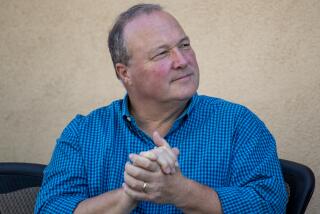He Wonders Why This ‘Wonder’ Drug Is Even Allowed
- Share via
Mike Soucek is the first to admit he’s obsessed. When a friend of his tipped me to this story, one of the first things Soucek told me when I phoned was that it would sound like “really bad, bizarre fiction. I’ve walked into the middle of something that I did not possibly think could exist in this country in this day and age.”
With that, Soucek unfolded the crusade that has dominated the last six years of his life. It’s a saga that began in March of 1986 when his wife, Ingrid, who had been taking one Halcion sleeping pill daily for six weeks, took 32 of them in one night.
She survived, but within two weeks she sustained a “corneal melt” and subsequently lost sight in her right eye. Since then, she’s had numerous operations on it, Soucek says.
The family, which includes four sons, grappled with the suicide attempt that, according to Soucek, “came out of absolutely nowhere.” Then, by chance four years later while in the Newport Beach library, Soucek stumbled on an article in the Washington Post, describing the long-running controversy over Halcion. Soucek learned for the first time that the sleeping pill he and his wife had been told was a “wonder drug” had been banned in the United Kingdom and linked to serious adverse reactions, including severe depression.
Convinced that Halcion induced his wife’s suicidal depression, Soucek set off on a quest that continues today. Now 58, Soucek has taken on the U.S. Food and Drug Administration and devoted himself virtually full time to getting Halcion off the market. Borrowing the title from Ralph Nader’s breakthrough book on the auto industry in the 1960s, Soucek says: “The drug is unsafe at any speed. . . . It’s a drug that can kill you, your wife, your parents, your children.”
Soucek is neither doctor nor pharmacist. His last full-time job, which he quit in 1986, was as a human resources director for Hughes Aircraft. What he brought to his Halcion task, he says, was an unquenchable thirst to explain his wife’s suicide attempt.
The scope of Soucek’s research is too vast to recount here. Suffice it to say he has 20 crates of documents and articles. He has 100 computer disks. He has had phone conversations with medical experts both here and abroad. He claims to have moles inside the FDA helping him.
“I have never done better work in my life and never felt stronger about anything in my life than I do about this subject,” he says. “I think that I have to do this.”
At the outset, the Souceks were financially comfortable enough that he could afford to dive in to the Halcion issue. Now, however, Soucek concedes his crusade has taken a toll. His wife, an insurance company administrator, and sons have expressed misgivings about his obsession, because the combination of medical bills and his research has “put the family on the brink of financial disaster.” In some months, his phone bill was as high as $2,000, he says. Soucek says he’s mortgaged the house to pay the ongoing expenses.
Not that Soucek set out to bankrupt himself. He believed his work might generate money from various sources, but it hasn’t. The family hasn’t sued Upjohn, the manufacturer of the drug, but it does have a claim against the FDA for an amount Soucek refuses to disclose.
“I figured this thing would all be over and done with in 1992,” Soucek says. “Then it became 1993 and ’94 and ’95 and ’96 and here we are, and when is it going to be over?”
Likening Halcion to tobacco, Soucek is convinced that both Upjohn and the FDA know Halcion has always been a “defective” drug. His conspiracy theory is a familiar one: The drug was simply too lucrative to keep off the market.
This is not to say that Soucek’s quest is quixotic. The case against Upjohn is not a figment of his imagination. Although approved by the FDA in 1983, the drug has a checkered past and has been the subject of numerous lawsuits and professional attacks.
While sold around the world, Halcion remains banned in Britain and a handful of other countries. Moreover, the prescribed dosage approved in the United States is now one-fourth the approved level when Ingrid Soucek overdosed on it. Halcion has credible medical opponents both here and abroad, and a 1994 series in the Houston Chronicle was strongly critical of the drug’s history in the United States.
The FDA is definitely aware of Mike Soucek. FDA spokesman Don McLearn told me that while the FDA has many private citizens involved in various causes, “I don’t know of anyone who matches the amount of effort he [Soucek] puts into it.”
Acknowledging the years-old controversy over Halcion, McLearn says the drug is safe and effective, if taken under prescribed conditions. In addition to reducing its recommended dosage over the years, he says, the drug now is packaged only in 10-pill units to reduce the threat of overdose.
That’s not enough for Soucek. He still hopes that congressional review will force Halcion off the market.
Even if you’re right, I asked him, why the obsession? Why jeopardize your financial health?
“I’m one of those strange, weird people who still believes goodness triumphs over evil,” he says, “and when we talk about heinous crimes, I don’t think there’s a more heinous pharmacological crime in history of the FDA.”
Dana Parsons’ column appears Wednesday, Friday and Sunday. Readers may reach Parsons by writing to him at the Times Orange County Edition, 1375 Sunflower Ave., Costa Mesa, CA 92626, or calling (714) 966-7821.
More to Read
Sign up for Essential California
The most important California stories and recommendations in your inbox every morning.
You may occasionally receive promotional content from the Los Angeles Times.













